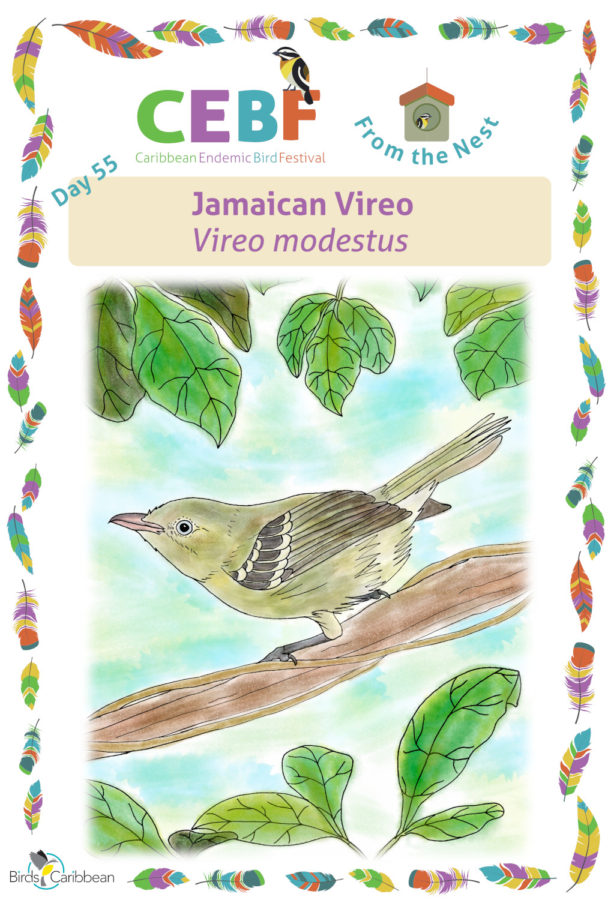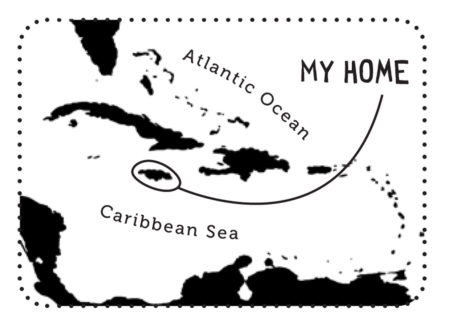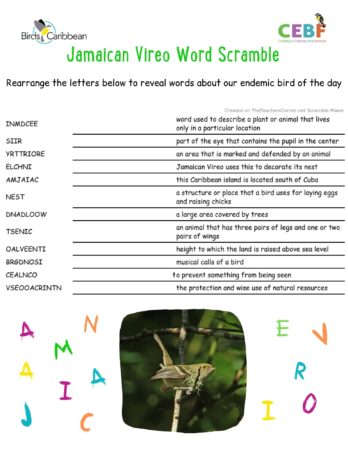Celebrate the Caribbean Endemic Bird Festival (CEBF) with us! Our theme in 2021 is “Sing, Fly, Soar—Like a Bird!” Have fun learning about a new endemic bird every day. We have colouring pages, puzzles, activities, and more. Download for free and enjoy nature with your family at home.
Endemic Bird of the Day: Jamaican Vireo
As its Latin name Vireo modestus suggests, the Jamaican Vireo is indeed rather modest in appearance. It is a small, rather rounded, grey-green and olive bird, whose main distinguishing features are its white iris, two white wing bars, pale yellow underparts, and bluish-grey legs. It is one of the least colourful of Jamaican endemic species. Its behaviour is unexceptional too. It can be a little hard to see because it tends to be skittish and stays hidden in dense vegetation, where it feeds on insects and small fruits. Its nest is a cup of finely woven fibers decorated with lichen. It is common and widespread, found on forest edges and roadsides at all elevations. Nothing special, you may think. But when it comes to song, this bird is unsurpassed in its variety and skill.
On almost any wooded trail in Jamaica, you may be sure to hear it. First, try to ignore the persistent, loud, and monotonous calls of its noisy cousin, the Black-whiskered Vireo Vireo altiloquus, whose insistent calls of “John Chew-it, sweet John” haunt the woodlands from March to September. Then, listen out for something very different—loud, sweet variations on the theme of “Witchy-witchy-woo.” How many variations? There are so many that experienced birdwatchers in Jamaica will tell you that if they hear a bird song they cannot recognize, it is almost certainly a Jamaican Vireo.
When you think you hear one, listen again; you might be hearing two. The Jamaican Vireo often engages in counter-singing, a common practice among male birds that are defending their territories. When the dominant individual sings, any rival nearby responds with the same song. The two will repeat this performance for several rounds, until one of them changes the song pattern, upon which the other will respond with the new song. This behaviour is called song type matching. It can go on for hours!
Song type matching is correlated with aggressiveness and willingness to get into a confrontation. Some species of birds are so aggressive that they respond before their rival has finished and their songs overlap. Not the Jamaican Vireo. He bides his time and only responds after a few seconds. This reminds us that no matter how important it is to make our voices heard, it is important to listen to what others have to say. Perhaps this is a small token of modesty. Learn more about this species, including its range, photos, and calls here.
Colour in the Jamaican Vireo
Download our West Indies Endemic Bird colouring page. Use the photos below as your guide, or you can look up pictures of the bird online or in a bird field guide if you have one. Share your coloured-in page with us by posting it online and tagging us @BirdsCaribbean #CEBFfromthenest
Listen to the song of the Jamaican Vireo
The song of the Jamaican Vireo is high-pitched with varied repeated phrases including “chi-wuh, chi-wuh, chi-wuh, zha” and “chi-wee“.
Puzzle of the Day
Click on the image below to do the puzzle. You can make the puzzle as easy or as hard as you like – for example, 6, 8, or 12 pieces for young children, all the way up to 1,024 pieces for those that are up for a challenge!
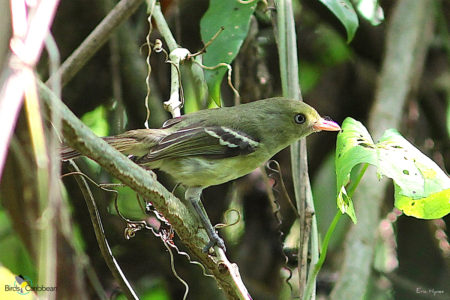
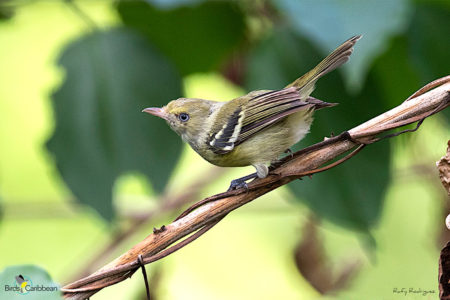
Activity of the Day
FOR KIDS: Use the information above and the clues on the sheet to untangle our our word scramble – all about the Jamaican Vireo, how it behaves and where is lives. You can find all the answers to the clues here.
FOR KIDS AND ADULTS: Enjoy the video below of a Jamaican Vireo in the wild! Can you spot it flitting about in the vegetation? Jamaican Vireos can be tricky to spot, not just because their drab grey-green colouring helps them blend into the background; but also because of their habit of hiding in dense vegetation. With their loud and varied “Witchy-witchy-witchy-woo” refrain you are more likely to hear this bird than see it!

